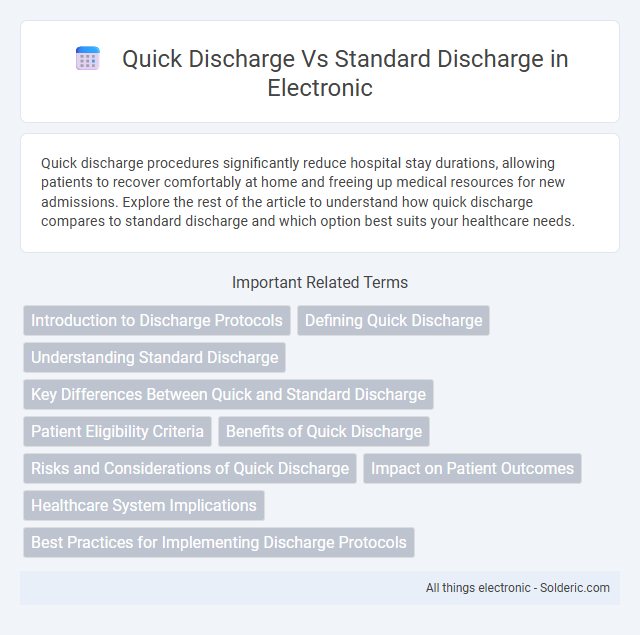Quick discharge procedures significantly reduce hospital stay durations, allowing patients to recover comfortably at home and freeing up medical resources for new admissions. Explore the rest of the article to understand how quick discharge compares to standard discharge and which option best suits your healthcare needs.
Comparison Table
| Feature | Quick Discharge | Standard Discharge |
|---|---|---|
| Discharge Speed | Fast, reduces time significantly | Moderate, controlled rate |
| Battery Stress | Higher stress, may reduce lifespan | Lower stress, extends battery life |
| Use Cases | Emergency power off, rapid cycling | Everyday devices, standard operations |
| Energy Efficiency | Less efficient due to rapid loss | More efficient energy management |
| Safety | Requires caution, risk of overheating | Safer, stable temperature control |
Introduction to Discharge Protocols
Discharge protocols play a critical role in patient recovery, influencing hospital workflow and patient outcomes. Quick discharge protocols prioritize accelerated patient turnaround by minimizing inpatient time through streamlined assessments and early mobilization, leading to reduced hospital stay costs. Standard discharge protocols emphasize comprehensive evaluation and stabilization, ensuring thorough post-discharge care planning to reduce readmissions and complications.
Defining Quick Discharge
Quick discharge refers to the rapid removal of accumulated energy from a battery or capacitor, enabling faster power delivery and shorter recharge cycles compared to standard discharge. This high-rate discharge capability is essential in applications requiring bursts of high power, such as power tools, electric vehicles, and emergency equipment. Your device's performance improves with quick discharge by reducing downtime and maintaining consistent energy output under demanding conditions.
Understanding Standard Discharge
Standard discharge refers to the gradual release of electrical energy from a battery or capacitor at a controlled rate, ensuring long-term stability and optimal performance. This method maintains the device's overall health by preventing rapid depletion or overheating, which can occur during quick discharges. Understanding standard discharge helps you manage energy consumption efficiently and prolong the lifespan of your electronic components.
Key Differences Between Quick and Standard Discharge
Quick discharge systems release energy rapidly, allowing devices to operate at high power for short durations, which is ideal for applications requiring bursts of intense performance. Standard discharge systems provide a steady, prolonged energy output, supporting extended operation times with consistent voltage levels suitable for everyday use. The primary difference lies in the discharge rate, with quick discharge favoring high current delivery but shorter lifespan and standard discharge prioritizing battery longevity and stable energy supply.
Patient Eligibility Criteria
Quick discharge protocols typically require patients to meet stricter eligibility criteria, including stable vital signs, minimal comorbidities, and adequate home support systems to ensure safety outside the hospital. Standard discharge criteria are broader, accommodating patients with more complex medical conditions or those needing extended monitoring due to potential postoperative complications. Both discharge types emphasize patient readiness, but quick discharge prioritizes rapid recovery indicators and lower risk profiles for early hospital release.
Benefits of Quick Discharge
Quick discharge systems offer significant benefits such as reduced downtime and enhanced operational efficiency by enabling faster removal of materials or fluids. This efficiency improvement is crucial in industrial processes where time-sensitive handling of substances reduces bottlenecks and increases throughput. Furthermore, quick discharge minimizes energy consumption and wear on equipment, leading to cost savings and prolonged machinery lifespan.
Risks and Considerations of Quick Discharge
Quick discharge protocols in healthcare settings can increase the risk of inadequate post-discharge support, leading to higher chances of readmission and complications such as medication errors or untreated symptoms. Patients discharged too soon may face poor wound healing, infection risks, and insufficient monitoring for adverse reactions, especially in elderly or chronically ill populations. Careful assessment of patient readiness and availability of follow-up care are critical to mitigate these risks and ensure patient safety during rapid discharge processes.
Impact on Patient Outcomes
Quick discharge protocols can significantly reduce hospital stay length, lowering the risk of hospital-acquired infections and promoting faster recovery in patients. Standard discharge processes, while thorough, may lead to longer inpatient durations that increase healthcare costs and delay rehabilitation. Your healthcare decisions benefit from balancing the efficiency of quick discharge with adequate post-discharge support to optimize patient outcomes and safety.
Healthcare System Implications
Quick discharge reduces hospital bed occupancy, enabling healthcare systems to treat more patients efficiently while minimizing resource strain. Standard discharge protocols ensure thorough patient stabilization but may increase healthcare costs and limit bed availability due to extended stays. Your healthcare facility can balance these approaches by assessing patient needs to optimize resource allocation and improve overall system capacity.
Best Practices for Implementing Discharge Protocols
Implementing discharge protocols requires clear criteria for quick discharge, including patient stability, pain control, and ability to perform basic activities independently. Standard discharge protocols benefit from thorough patient education, medication reconciliation, and scheduled follow-up appointments to reduce readmission risk. Consistent communication among multidisciplinary teams ensures tailored discharge plans that improve patient outcomes and resource utilization.
Quick discharge vs Standard discharge Infographic

 solderic.com
solderic.com